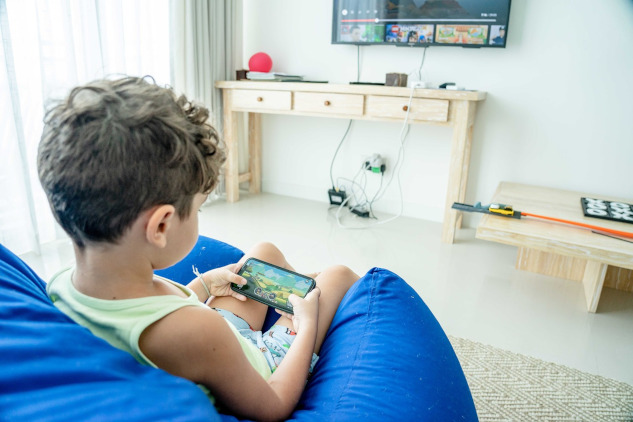
Image by Oleksandr Pidvalnyi
In this Article:
- What persuasive design tricks are used in kids' apps and games?
- How do rewards and streaks keep children hooked on games?
- What can parents do to help manage kids' screen time?
- How do leaderboards and reputation metrics affect kids' app usage?
- Why should parents be concerned about variable rewards and in-app purchases?
Design Tricks Hook Your Kids on Games and Apps: 3 Things You Can Do About It
by Chris Zomer, Deakin University and Sumudu Mallawaarachchi, University of Wollongong.
Ever found yourself unable to resist checking out a social media notification? Or sending a random picture just to keep a Snapchat “streak” going? Or simply getting stuck staring at YouTube because it auto-played yet another cute cat video?
If so, you’re far from alone. And if we adults can’t resist such digital temptations, how can we expect children to do any better?
Many digital environments are not designed with the best interest of users in mind – and this is especially true of games, apps and platforms commonly used by kids and teens.
Designers use persuasive design techniques to make users spend more time on apps or platforms, so they can make more money selling ads. Below, we explain some of the most common design tricks used in popular games, social media and apps.
Decision-making made easy
Social media and streaming platforms strive to provide “seamless” user experiences. This makes it easy to stay engaged without needing to click anything very often, which also minimises any obvious opportunities where we might disengage.
These seamless experiences include things such as auto-play when streaming videos, or “infinite scrolling” on social media. When algorithms present us with a steady flow of content, shaped by what we have liked or engaged with in the past, we must put in extra effort to stop watching. Unsurprisingly, we often decide to stay put.
Rewards and dopamine hits
Another way to keep children engaged is by using rewards, such as stars, diamonds, stickers, badges or other “points” in children’s apps. “Likes” on social media are no different.
Rewards trigger the release of a chemical in our brains – dopamine – which not only makes us feel good but also leaves us wanting more.
Rewards can be used to promote good behaviour, but not always. In some children’s apps, rewards are doubled if users watch advertisements.
Loot boxes and ‘gambling’
Variable rewards have been found to be especially effective. When you do not know when you will get a certain reward or desired item, you are more likely to keep going.
In games, variable rewards can often be found (or purchased) in the form of “loot boxes”. Loot boxes might be chests, treasures, or stacks of cards containing a random reward. Because of the unpredictable reward, some researchers have described loot boxes as akin to gambling, even though the games do not always involve real money.
Sometimes in-game currency (fake game money) can be bought with real money and used to “gamble” for rare characters and special items. This is very tempting for young people.
In one of our (as yet unpublished) studies, a 12-year-old student admitted to spending several hundred dollars to obtain a desired character in the popular game Genshin Impact.
The lure of streaks
Another problematic way of using rewards in design is negative reinforcement. For instance, when you are at risk of a negative outcome (like losing something good), you feel compelled to continue a particular behaviour.
“Streaks” work like this. If you do not do the same task for several days in a row, you will not get the extra rewards promised. Language learning app DuoLingo uses streaks, but so does Snapchat, a popular social media app. Research has shown a correlation between Snapchat streaks and problematic smartphone use among teens.
Streaks can also make money for apps directly. If you miss a day and lose your streak, you can often pay to restore it.
Loss of reputation
Reputation is important on social media. Think of the number of Facebook friends you have, or the number of likes your post receives.
Sometimes designers build on our fear of losing our reputation. For instance, they can do this by adding a leaderboard that ranks users based on their score.
While you may have heard of the use of leaderboards in games, they are also common in popular educational apps such as Kahoot! or Education Perfect. Leaderboards introduce an element of competition that many students enjoy.
However, for some this competition has negative consequences – especially for those languishing low in the ranks.
Similarly, Snapchat has a SnapScore where reputational loss is still at play. You do not want a lower score than your friends! This makes you want to keep using the app.
Exploiting feelings of connection
Another tool in the designers’ bag of tricks is capitalising on the emotional ties or connections users form with influencers or celebrities on social media, or favourite media characters (such as Elmo or Peppa pig) for younger children.
While these connections can foster a sense of belonging, they can also be exploited for commercial gain, such as when influencers promote commercial products, or characters urge in-app purchases.
What can parents do?
Persuasive design isn’t inherently bad. Users want apps and games to be engaging, like we do for movies or TV shows. However, some design “tricks” simply serve commercial interests, often at the expense of users’ wellbeing.
It is not all bleak, though. Here are a few steps parents can take to help kids stay on top of the apps:
-
have early and ongoing discussions with children about ideas such as the underlying commercial intent of what they are engaging with
-
model good digital choices of not giving in to persuasive design, such as by avoiding digital distractions yourself
-
use trustworthy resources to help in digital decision-making, such as Common Sense Media and Dark Pattern Games.
For the moment, the responsibility for managing children’s interactions with the digital realm falls largely on individuals and families.
Some governments are beginning to take action, but measures such as blanket age-based bans on social media or other platforms will only shield children temporarily. A better approach for governments and regulators would be to focus on safety by design: the idea that the safety and rights of users should be the starting point of any app, product or service, rather than an afterthought.![]()
Chris Zomer, Associate Research Fellow at the Centre of the Digital Child, Deakin University and Sumudu Mallawaarachchi, Research Fellow, ARC Centre of Excellence for the Digital Child, University of Wollongong.
Article Recap:
This article explains how persuasive design tricks in kids' apps and games are used to keep children engaged, often to the detriment of their wellbeing. Techniques like rewards, streaks, and infinite scrolling create a loop of engagement that is hard to break. Parents can help manage screen time by having open discussions about these tactics, modeling healthy digital behaviors, and using trusted resources. Safety by design in apps should be prioritized to protect kids in the digital space.
This article is republished from The Conversation under a Creative Commons license. Read the original article.

Related Books:
Here are 5 non-fiction books on parenting that are currently Best Sellers on Amazon.com:The Whole-Brain Child: 12 Revolutionary Strategies to Nurture Your Child's Developing Mind
by Daniel J. Siegel and Tina Payne Bryson
This book provides practical strategies for parents to help their children develop emotional intelligence, self-regulation, and resilience using insights from neuroscience.
Click for more info or to order
No-Drama Discipline: The Whole-Brain Way to Calm the Chaos and Nurture Your Child's Developing Mind
by Daniel J. Siegel and Tina Payne Bryson
The authors of The Whole-Brain Child offer guidance for parents to discipline their children in a way that promotes emotional regulation, problem-solving, and empathy.
Click for more info or to order
How to Talk So Kids Will Listen & Listen So Kids Will Talk
by Adele Faber and Elaine Mazlish
This classic book provides practical communication techniques for parents to connect with their children and foster cooperation and respect.
Click for more info or to order
The Montessori Toddler: A Parent's Guide to Raising a Curious and Responsible Human Being
by Simone Davies
This guide offers insights and strategies for parents to implement Montessori principles at home and foster their toddler's natural curiosity, independence, and love of learning.
Click for more info or to order
Peaceful Parent, Happy Kids: How to Stop Yelling and Start Connecting
by Dr. Laura Markham
This book offers practical guidance for parents to shift their mindset and communication style to foster connection, empathy, and cooperation with their children.























